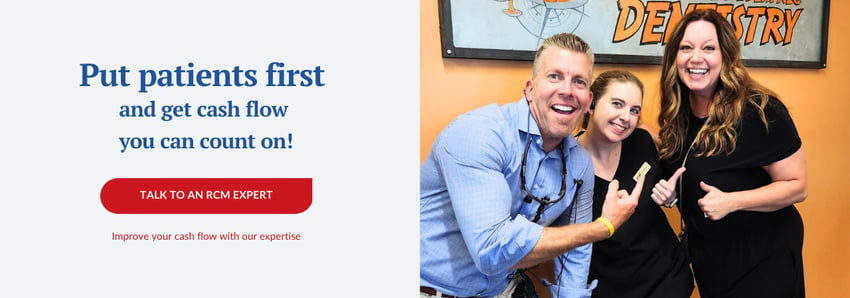3 reasons to put your PPO plan details into your dental software


When it comes to properly setting up specifics in your dental practice management software, dental teams can struggle to understand what they need to do.
Especially when it comes to setting up PPO insurance plan details (preferred provider organization) and the PPO negotiated fee schedules in the software, dental teams struggle to understand how to properly do so and why it’s so important to their stream of revenue.
Unfortunately, doing dental billing without setting up your PPO properly can cause more problems than you’d think.
At Dental ClaimSupport, this is something we talk to all of our participating PPO dental offices about. We’ve even helped some practices set it up for them. This is because we know how it can affect productivity, cash flow, and the overall health of your dental practice.
In this article, we will share 3 big reasons why you should make it a priority to properly set up your PPO in your dental practice management software. By understanding these benefits such as saving time, money, and accuracy, you’ll know why taking the steps to complete this set-up is worth the time and training.
First, let’s get into what it means to set up your PPO and why it’s essential. Then we will cover the benefits of properly setting up your PPO in your practice management software.
What does it mean to “set up” your Preferred Provider Organization (PPO) in your dental practice management software?
So let’s do a quick recap of what a PPO is: PPO stands for Preferred Provider Organization. For this type of insurance, patients typically have a choice of going to an office within your network or sometimes out of network.
A PPO insurance may have a copay or an out-of-pocket percentage for the patient to pay, depending on which plan the employer provides or the patient has purchased.
When we talk about setting up the PPO, it means that the negotiated PPO fee schedule is added to the practice management software database if it is not already there.
If the fee schedule for that PPO is already in your database, then you will want to compare and edit the fee schedule accordingly. Please note that not all fees change with new PPO fee schedules, compare all of your common codes to make sure your data is accurate.
Professional Tip: When you create or edit your fee schedules, consider giving them a title such as Metlife PPO December 2022 update.
This way you will know when you received your last fee change without having to look at your file. We have seen some offices working off of fee plans from 2018. Make sure your fee schedules are up to date and also fair to your practice.
Why is it important to properly set up your PPO in your dental practice management software?
There are a few benefits obviously, and we’ll get to those. But let us walk you through an example of what it looks like to properly set up your PPO.
Most consultants recommend you keep your PPO write-off under 20% of the full fee, depending on the overhead of your practice.
The insurance company name, address, and payer ID numbers are added to your software if it is not listed in your shared software database. Be sure to not create a new insurance company if there is already a company with the same exact information, as this complicates reporting, address changes, and is time-consuming to clean up down the road.
The plan is then created and is usually associated with the employer. This plan is a shared database in your software. The plan is where all of the information about the coverage for that employer with a specific group number or plan is stored along with the negotiated fee schedule.
Do not add multiple plans for the same employer with the exact same group number or plan as this is a mess to clean up down the road.
Let’s dive into what this actually looks like
So let's say, for example, the patient’s employer is Bank of America, and the insurance the employer uses is Metlife.
You would set up Bank of America as the plan, indicating it is a PPO-type plan. You’ll then specify the specific group number for the plan, attach Metlife as the insurance carrier to the plan, and then attach the Metlife fee schedule you previously created to that plan.
Note that some employers may offer different levels of coverage with the same insurance carrier and they will typically have different group numbers, but not always.
Also, don't forget to update the plan details such as anniversary month, deductibles, maximums, wait periods, percentages, and all other necessary details and notes.
If everything is set up properly, your software will then estimate the proper patient and insurance estimated amount due by pulling the percentages from the Metlife negotiated PPO fee schedule and plan details.
You will improve your patient OTC collections, give your administrative team members more time to spend on keeping the schedule full, spend less time and money sending patient billing statements, and it is a win-win for the practice as well as the patients.
The treatment plans and patient ledgers/transactions should reflect your full fee. Professional tip: Your PPO write-off should only be posted when it is the final payment for the primary and or the secondary plan because you do not want to give the patient a false credit (this is a common error by non-professional billers).
Let’s get into the specific reasons why it’s beneficial to properly set up your PPO and the effect it can have on the health of your dental practice.

Reason #1: Setting up your PPO will save you time
First thing’s first: you’re going to save a lot of time in the long run when you properly set up your PPO in your dental software.
A lot of dental teams don’t even notice the chaos that can ensue when trying to calculate estimated patient responsibility without the PPO fee schedule set up.
Office managers or insurance coordinators are scrambling to figure out the calculation, running to grab their big binder book that has all of the fee schedules in it. Meanwhile, the patient is waiting for you to let them know what they’re owed.
If the patient is waiting - it can be tempting to say, “Oh, I’ll just mail you a bill!” And we all know that patient amounts are far less likely to be paid if the bill comes in the mail. Not to mention, patients don’t love mailing checks! Plus all of this postage is just a delay in you receiving payment. All the while, you could have posted their portion to the software the day of their procedure.
So it’s crucial that dental teams understand how to set up their PPOs properly to work more efficiently and receive payments efficiently.
Reason #2: Setting up your PPO will help your practice bring in more money
This benefit seems a little outlandish because you’re just setting up your software for your PPO correctly, right?
But it’s more than that. Every part of the billing process affects the previous step, no matter if you’re a DHMO or a PPO dental practice.
Setting up your PPO properly will increase your collections because if you're collecting the proper amount, then you don't have to write refund checks or send patient statements.
For example, if you just received $100 from a patient and you didn't have your PPO fee schedule in your practice management software, they might have actually only owed $90. When you get your reimbursement from insurance and write the adjustment off, you now have a credit balance.
Then your office manager has to write a check because you collected too much. It's a lot of administrative work and accounting work. Or if you didn’t collect enough and you now have to send a statement. This frustrates the patients and the team!
Collecting the most accurate estimated portion due at the date of service helps improve your patient’s trust and confidence in the practice. Speaking of the proper amount, let’s talk about patient out-of-pocket costs.
Reason #3: Setting up your PPO will calculate your patient out-of-pocket estimations more accurately
When you set up your PPO in your practice management software, you’re going to have more accurate calculations when it comes to your patient’s financial responsibility. With the fee schedules in place and the patient’s insurance information properly input into the software, it will estimate the proper fee for you to bill the patient. It does the work for you!
For example, let's say the patient’s insurance covers 50% of a crown, and let's say the crown is $1,000.
So at first, you’re thinking, “Okay, the patient is going to owe $500, right?”
Well actually, because of the fee schedules in place and your PPO properly set up, the patient will only owe $400, because the allowed amount is only $800.
If you put the deductible, maximums, benefit year, waiting period, and percentages into the plan you will even have a better estimate. It is hard to believe one simple step of setting up your plan properly can save you time and money!
If you didn’t have your PPO properly set up, you might charge your patient more than they actually owe because all you’re seeing is their full breakdown and not what’s actually in your contract with the insurance company.
And that’s where the insurance companies get you: the fine print that they know dental professionals will overlook.
Ready to keep learning about how to properly use your dental software?
There are parts of the dental software that plenty of dental teams struggle to optimize and understand.
You’re not alone! And setting up your PPO can feel like a huge task that you don’t have time to get done, but the time and money saved with the more accurate patient responsibility estimations can lead to a more productive and healthier dental practice.
Dental Claims Academy is a great resource within Dental ClaimSupport for those looking for more training on software and insurance billing rules.
Through courses and community groups, you’ll find that our experts have been where you are and are excited to help you optimize your insurance claims income.
Learn more about DCA by visiting our website.
Related Posts
Dental revenue resources from Dental Claim Support

